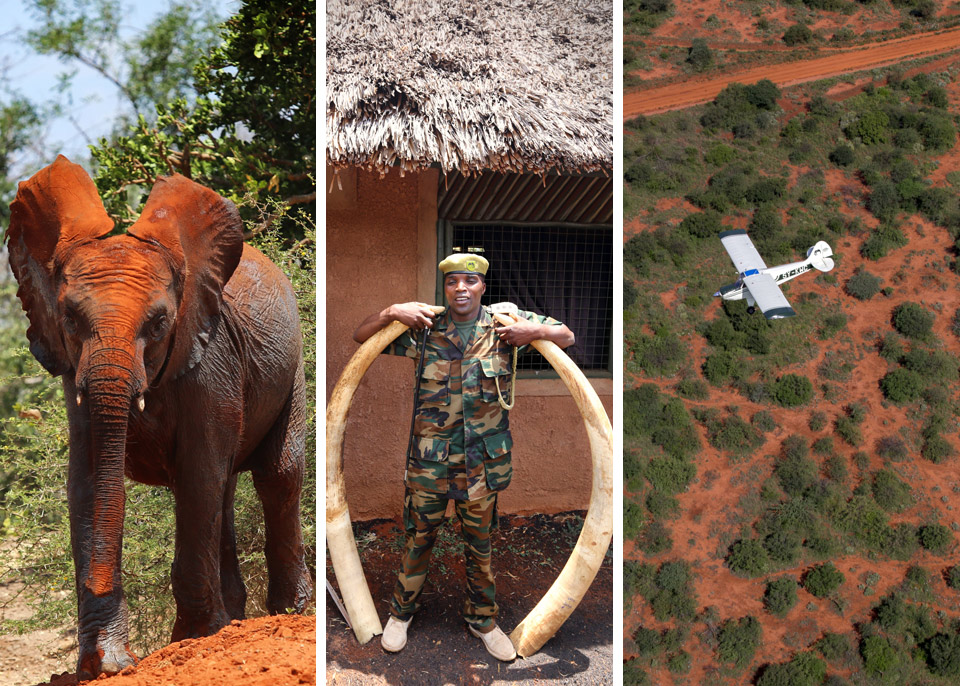
An elephant orphaned by poaching is now being raised by the Kenya Wildlife Service with plans to eventually release it back to the wild (far left). Tusks from a large elephant that died from natural causes were recovered by rangers. Weighing 93 pounds, these tusks together are worthapproximately $80,000 on the black market (center). A KWS Husky framed against the distinctive red soil of the Tsavo region (right).
Acacia trees and red, dusty ground flash past just below the open door of a Super Cub as George Mwangi flies low toward a section of Kenya Wildlife Service (KWS) rangers deploying in combat formation from a truck.
Dressed in camouflage fatigues and armed with assault rifles, the rangers dismount and move forward with heads low, advancing in turns to encircle a trio of armed men toting guns and elephant tusks. Ivory today is worth more than $900 a pound on the black market, a price that has increased dramatically in recent years. These particular “poachers” were actually rangers dressed to look the part of Somali poachers, who often travel many miles on foot to kill on land protected by KWS rangers and pilots.
The rangers were staging a demonstration of a mission that recurs frequently, with casualties on both sides, across their country. Kenya, like many African nations, has been for decades locked in a struggle to protect the same animals that fuel its tourist trade, including elephants and black rhinos, which have been driven to brink of extinction—in large part because rhino horns now fetch nearly $30,000 a pound on the black market, more than 10 years’ honest wages in this part of the world.
“It is a heritage that we have to conserve for the whole of humanity,” said Robert Muasya, acting deputy director of security for the Kenya Wildlife Service.
“KWS has lost 61 people in the line of duty over the past 20 years, and it’s become increasingly frequent,” Clark said, noting that about 1,000 rangers have been actively deployed for wildlife protection during that time. Their numbers are rapidly increasing, with 575 rangers being trained to boost the ranks of those deployed to fight poaching; about 1,500 more rangers are assigned to other duties in the field. While the government has increased its investment, and is expanding the ranger force, Kenya needs more support, he said, including more aircraft— Super Cubs, Huskys, and a Super Decathlon—are on his wish list.
Pilots flying over protected land in aircraft with KWS insignia can deter poaching by their very presence, although the force remains thinly spread. The KWS Airwing has about a dozen aircraft (three of which were being rebuilt as of July 2014) and a dozen pilots to cover a country nearly the size of Texas. Clark wishes that he could bring groups of pilots like Wagstaff, Sugden, and Spencer every year, because flying for KWS demands a high level of skill that deteriorates quickly in the absence of recurrent training.
Benefactors like Sugden and Spencer (who supplied satellite beacons capable of reporting position and summoning help); organizations including The Charles A. and Anne Morrow Lindbergh Foundation, which has supplied aircraft, fuel, and other resources; and individuals like Wagstaff have made a difference, Clark said, but much more is needed. “To my mind, it is unrealistic and it is also unfair to expect a developing country, particularly Kenya, or any others, to carry this enormous burden of protecting world heritage by itself,” Clark said. “They’re left carrying a burden which is really too heavy for them.”
Email [email protected]
“He must have been using a G3,” Ochieng said, referring to a high-powered battle rifle that is also used by rangers. “I was flying at almost 50 feet above the ground. He was actually very accurate.”
One round pierced the left wing, narrowly missing the fuel tank, and Ochieng began to maneuver evasively, while keeping both the remaining poachers and rangers in sight. Drawing fire, Ochieng helped reveal the poachers’ position among the thorny bush. “If I was not there to reinforce them, it would have been more disastrous,” Ochieng said. “They were able to gun him down.”
During visits to nearby Amboseli National Park, and a rhino sanctuary at the foot of the Ngulia Hills in Tsavo West National Park that offers fences and ranger protection to about 90 black rhinos—up from three when the sanctuary was created in 1996—Muasya said that poachers remain determined to avoid capture by whatever means necessary, though KWS hopes to capture more of them alive in the coming years. There is some hope that captured poachers might lead rangers to the middlemen that finance and orchestrate the black market trade.
Clark had brought a pair of Israeli police K-9 officers to Kilaguni, and was working with them to coordinate deployment of attack dogs capable of stopping a fleeing poacher and holding him (they are nearly always men) until rangers can safely complete the capture.
It is, however, a more complex problem than simply capturing poachers, Muasya explained. Population growth has fueled increasing demand for farming and grazing land, and there are more frequent incursions into the protected areas for those purposes. Farmers compete with elephants, lions, and a host of other animals—the very resource that finances, through tourism taxes and fees, 70 percent of the KWS budget—for territory and precious water in this equatorial country. KWS rangers and pilots spend more and more time each year guarding against this kind of incursion and depletion. While the loss of 59 rhinos in a year—in a country with an estimated population of a few hundred of the animals, at most—is far from sustainable, it represents a “success story,” Muasya said. Losses in years past were higher still.
As the government devotes more resources to the mission, poachers are also upgrading, empowered to do so by the ever more lucrative ivory and rhino horn trade. There is concern that poaching gangs have gained access to rocket-propelled grenades, satellite phones, and perhaps even night vision equipment. Clark seeks donations that will allow Kenya to keep up with what amounts to an arms race—and a race against extinction that would devastate a country whose economy depends largely on tourism.
‘It’s a war.’ Flying low, KWS pilots learn to watch for thin columns of smoke from cooking fires, although poachers have learned to limit such telltales. Circling vultures are often the first indication that poachers have made another kill. Pilots must be cunning, and avoid heading directly toward their quarry, lest they alert the watchful criminals and prompt them to vanish into the bush.
Rangers on the ground must be equally cunning. “It’s a war, basically,” said Kevin Opondo, a ranger assigned to the rhino sanctuary within Tsavo West. “Nobody’s coming here for a Christmas party.”
Clark, a U.S. Marine long since retired from active duty, disagrees with the use of the word “war”—he describes it in more nuanced terms, something more like a police action, although the casualty rate among the KWS exceeds that of many armies.
Mistakes at low altitude are the most common cause of losses. “Some of the Huskys have been rebuilt six times,” Clark said. “You can see the welds of how many times the fuselage has been reassembled.”
Wagstaff said she has worked on the same issues throughout her visits, focusing most on basic aircraft control and the precision, low-level flying that she is known for. She works to “get any cowboy tendencies out of them,” and develop the reflexive control coordination that is essential to staying alive when flying low with attention directed entirely outside. In a country where a private pilot license costs a typical student about five years’ pay or more, flight schools and qualified instructors are scarce. “They don’t have really good stick-and-rudder-type instructors,” said Wagstaff, who has spent more time here than anyone but Clark.
‘This is the life.’ Three of the five aircraft tasked with patrolling Kenya’s parks were assigned to Kilaguni for the week, and one was lost. Word arrived one morning of a crash during an attempted takeoff at a dirt strip a few miles away, drawing scowls and looks of concern. Clark and a few others hustled to the scene. This time, there were no injuries, although the Husky (donated by Sugden in 2010) had flipped on its back and was badly damaged.
“This is the life,” said Mwiti. He said it without irony, meaning “this is the life we lead.”
In Kilaguni, the lessons would continue in the aircraft that remained, senior pilots taking turns in the back seat (or right seat, in the Cessna 182), sharpening skills needed to teach the next generation. The junior pilots continued work on the basics, and prepared to survive dangerous missions that put them within reach of rifle fire.
Kenneth Ochieng found that out firsthand a few years ago, supporting rangers engaged in a firefight near the coast, not far from Mombasa, where illegal ivory and rhino horn taken in Kenya and other countries often passes unseen by inspectors in sealed shipping containers bound for Asia and elsewhere. He received a 5:30 a.m. call from Nairobi with orders to launch and fly to the scene of a firefight with desperate poachers. Lives had been lost on both sides, and as Ochieng approached, a wounded poacher fired at Ochieng’s aircraft.
This weeklong clinic in Kilaguni is the first held in three years, and the Kenyan pilots are grateful for a chance to sharpen their skills and spend extended time with their peers. Deployed for months at a time to cover 59 national parks and reserves scattered across Kenya’s 225,000 square miles, they rarely see one another.
Mwangi and other senior pilots spoke of rust and bad habits that can take hold in such isolation, and stick-and-rudder skills that lose sharpness in the absence of regular training.
Poor control coordination or inattention to detail don’t always lead to trouble right away, said Kenneth Mwiti, a KWS pilot who was nearly killed in a crash. After years—and thousands of hours—of flying alone, complacency sets in. “It becomes normal,” Mwiti said. “Even if it’s a deviation, it becomes a normalization of deviation.”
Newly minted private pilots with little more than 100 hours each comprised about half of this group in Kilaguni, and they had the most to learn, having yet to see their first combat, drop water or other supplies to rangers on patrol in the bush, or fly wounded rangers to distant hospitals.
“We’ve been scraping hard for aircraft,” Clark said. He made an impassioned plea to the pilots for care and caution as the clinic began, telling the group that donations from overseas benefactors were precious, and might not continue if aircraft continued to be lost—on missions that were supposed to be routine. The Americans spent much of the time in classrooms and cockpits focusing on the basics: flying square patterns, rudder coordination, and the use of checklists that usually are dispensed with as the Kenyan pilots gain familiarity with their aircraft and begin to rely on a flow.
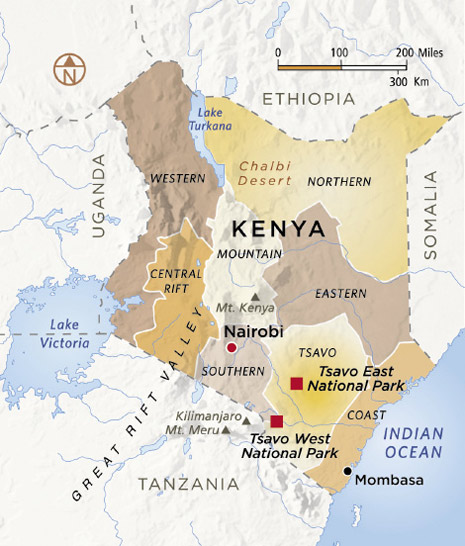 Mwangi was flying a typical mission profile, not far from clipping treetops as he scanned for targets on the ground. He is one of the more senior pilots in the small KWS Airwing, assigned to support rangers with supplies, medical evacuation, and reconnaissance. He is the lone airman tasked to cover both Tsavo East National Park and Tsavo West National Park (along with some surrounding areas), a total patrol assignment about the size of New Jersey. He has logged more than 5,000 hours in his Super Cub since he transitioned from ranger to pilot seven years ago. Like others in the small corps of KWS aviators, he usually is the first to detect a killing.
Mwangi was flying a typical mission profile, not far from clipping treetops as he scanned for targets on the ground. He is one of the more senior pilots in the small KWS Airwing, assigned to support rangers with supplies, medical evacuation, and reconnaissance. He is the lone airman tasked to cover both Tsavo East National Park and Tsavo West National Park (along with some surrounding areas), a total patrol assignment about the size of New Jersey. He has logged more than 5,000 hours in his Super Cub since he transitioned from ranger to pilot seven years ago. Like others in the small corps of KWS aviators, he usually is the first to detect a killing.
“It’s very painful,” Mwangi said. He has been more fortunate than many of his comrades, who have survived crashes and recovered from injuries; a few have lost their lives on missions like this. Flying so low, he has been shot at by poachers. Mwangi fights discouragement as the tolls mount. Kenya lost 59 rhinos in 2013, and many more elephants—nearly one each day, on average. “It has to stop,” Mwangi said. “This destruction. This killing. It’s not even really human. I don’t know what to call it.”
So Mwangi flew by the seat of his pants, eyes outside, circling the group of “poachers” that all too often are the real thing, his comrades on the ground closing in on them. A red yaw string taped to the center of the Super Cub’s windshield by visiting American pilots swung back and forth as he turned, banking with a very slim margin of error, perhaps a hundred feet off the ground on this day.
Stick and rudder. Patty Wagstaff, a three-time U.S. national aerobatic champion and acclaimed airshow pilot, has made it her own mission to help KWS execute its difficult and dangerous job. For the eighth time since 1999, Wagstaff spent a little more than a week in Kilaguni spanning late February and early March. Along with two fellow American pilots—Dr. Richard Sugden, making his third visit to Kenya, and Richard Spencer, his first—they flew with a dozen KWS pilots (nearly the entire group). Wagstaff was first recruited by Bill Clark, an American biologist who has worked with Kenya’s government since the 1970s, and helped create the KWS air wing in 1990. Clark is an honorary warden of the KWS, a prestigious rank given in recognition of his many contributions. He has over the years secured many of the resources deployed in the air: donations of aircraft as well as volunteer trainers including Wagstaff, John and Martha King, and others who have made the trip to east Africa.
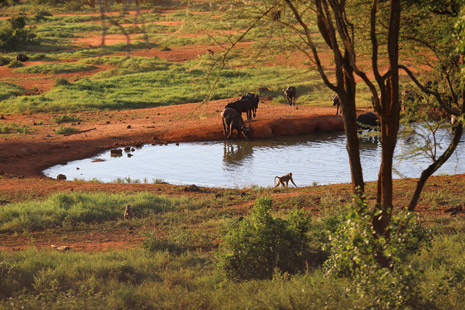
African buffalo visit a Kilaguni waterhole
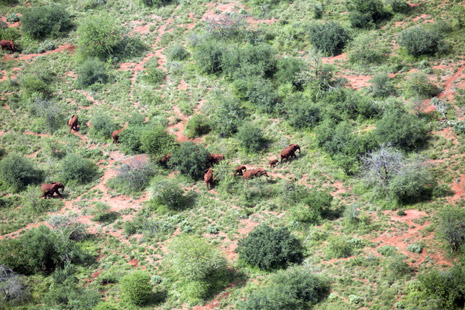
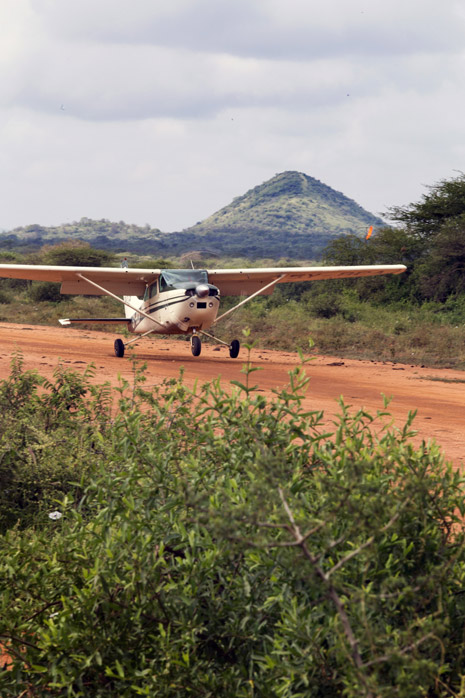
Takeoffs andlandings in Kilaguni require vigilance, as the runway is outside the fenced area thatprotects the nearby lodge and is frequented by elephants, buffalo, giraffes—and the occasional lion.
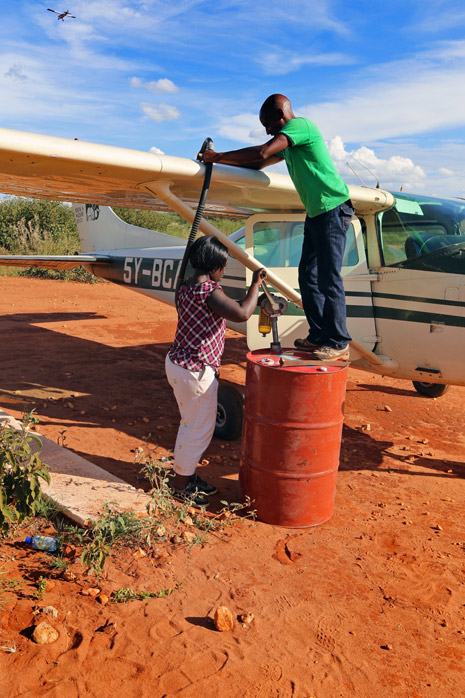
Fuel pumped by hand from drums is rationed carefully.
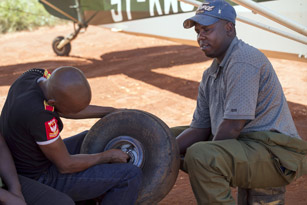
A KWS Airwing mechanic joined the group in Kilaguni and made necessary field repairs. Such tasks sometimes fall to pilots patrolling remote regions.
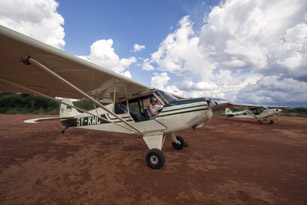
KWS Airwing Huskys were called to Kilaguni for the weeklong clinic.
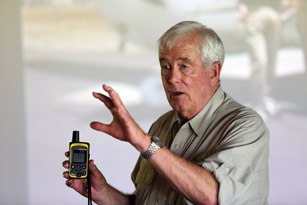
Dr. Richard Sugden explains the use of donated satellite beacons.
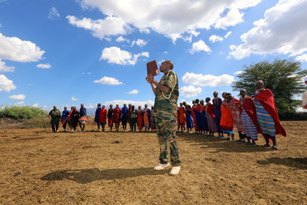
KWS has forged relationships with the traditionally nomadic Maasai.
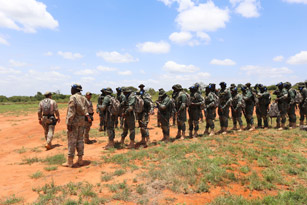
The KWS Field Training School—Manyani, located within Tsavo West National Park,
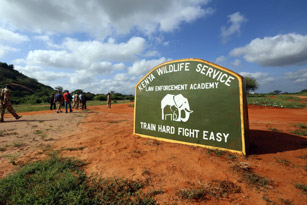
has expanded significantly in recent years.
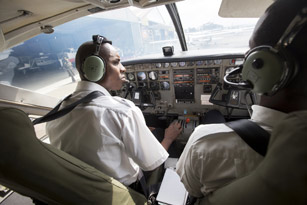
The crew prepares the KWS AirwingCaravan for departure fromNairobi.
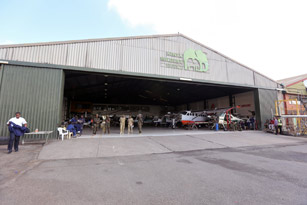
The KWSAirwing is based in a WilsonAirport hangar in Nairobi.
Lindbergh was here
Charles Lindbergh visited Kenya in 1964. His itinerary included a stop in Kilaguni, where modern pilots train to protect the nation’s wildlife, and where the tree referenced in his 1964essay, “Is Civilization Progress?” still can be found today:
“Lying under an acacia tree with the sounds of dawn around me, I realized more clearly facts that man should never overlook: that the construction of an airplane, for instance, is simple when compared to the evolutionary achievement of a bird; that airplanes depend on an advanced civilization; and that where civilization is most advanced, few birds exist. I realized that if I had to choose, I would rather have birds than airplanes.”
Man-eating lions
Kenya’s Tsavo lions, a species distinct from other African lions, have earned a reputation as man-eaters, although it has been inflated over the years by legends and tall tales. Still, expansion of agriculture and human habitation has increased the conflict between man and beast, and the lions do occasionally kill. Scientists confirmed in 2010 that a pair of male lions killed by a British hunter in the nineteenth century, the pelts of which are on display in The Field Museum in Chicago, had, in fact, eaten just under three dozen people between them in the weeks before their own demise. The lions’ chosen meals were, by and large if not exclusively, Punjab laborers imported to build a rail line that remains in service today. KWS rangers say they often encounter lions while patrolling the bush, and their strategy in close encounters is to maintain eye contact with the animal (or animals) while slowly but deliberately exiting the area. The eye contact, the ranges said, discourages lions from attacking, since they prefer to capture their prey by surprise.
A thin flying force
Kenya Wildlife Service Airwing currently operates 11 fixed-wing aircraft (three of which are to be rebuilt after accidents) and two helicopters, with 12 pilots. The Airwing is based in Nairobi, where the maintenance staff also services other aircraft.
Kenya: 224,900 square miles
Texas: 228,600 square miles



